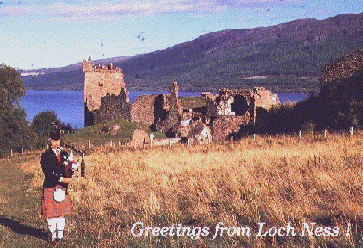
What a day we picked to visit Loch Ness and Urquhart Castle! It was a long drive from Aberdeen to begin with and we had been hoping for nice weather so as to enjoy the scenery along the way... however, it rained from the moment we set off until just before we arrived! Not only that, but the fog was so thick throughout the entire 3-4 hr drive, that we couldn't see much of anything even if it hadn't been raining. We were not to be put off though, and I have to say that our first glance of the castle will never be forgotten... all shrouded with fog- it looked very eerie and very mysterious at the same time. However, by the time we'd had lunch (a must with a toddler on board!), the fog had lifted, making the final 10 minute drive to the castle very scenic indeed.
When we think of a castle, we tend to think high up- atop a hill-afterall, that is a much more commanding position. Urqhuart castle is situated somewhat differently-the approach to the castle from the parking area is downhill, giving one the observation that it must have been difficult to defend such a castle, as the enemy would have the advantage of sneaking up on the castle from above. As it was, back in Urquhart's days, the principal danger came from not above, but from below-the loch itself. And in this situation, Urquhart had all the advantage, being that most of the castle was surrounded by the loch.

The remains of the castle we see today date back to the 13 th century, with the massive tower-house dominating the southern bailey. It is still climbable and gives most a good impression of how it must have looked back in its hey days... as for the rest of the castle, it is more difficult, as there are mainly just stumps of walls and bits of pathways left over. The tower-house was the lord of the castle's private residence, with very restricted access- a deep ditch can still be seen along the two sides of the tower that border the inner close- this increased the tower's defensive capabilities.
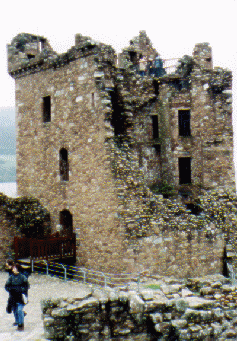
|
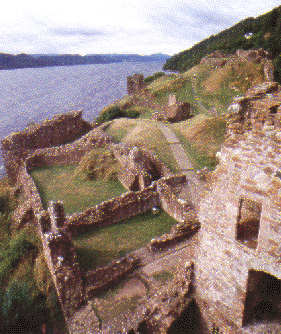
|
| Towerhouse | Great Hall & Kitchen |
The gatehouse is one of the other structures that is still semi-intact- enough so that one can get a general idea of how it must have once looked. It is through this that we enter the castle. The gatehouse also provided some residential accomodation aside aside from guarding entry into the castle. The resident here would most likely have been the constable- keeper of the castle- the lord's right hand man. The main entry here while wide enough to allow carts & horses to pass through was well defended. First there was the Portcullis (big iron gate), after going through the gate, one enters a small passage way that once had a timber decking above it, in which were several 'murder holes' through which various items could be thrown down onto would-be attackers, including- rocks, arrows, and even boiling water.
Once through the entrance passage, there is a lodge, encompassing both sides of the inner gatehouse. The North Lodge is entered directly from the passageway, and was where the porter lived - he controlled the entry into the castle, and guarded any prisoners in a very small prisoner's cell which can still be seen today (complete with life-like looking prisoner!). The South Lodge was entered from the courtyard and was turned inot a kiln, where corn was dried.
Once in the courtyard of the castle, we can appreciate the castle a little more- looking to the right we see the upper bailey and to the left, the lower or nether bailey. The only recognizable feature of the upper bailey (where the earliest castle would probably have been situated), is the Dovecot. The dovecot was a regular feature of medieval castles, and it was were the pigeons were stored for eventual consumption by the inhabitants of the castle. There are still four nesting boxes that survive today. You can see the dovecot below, on the aerial picture of Urquhart.
Almost directly across from the gatehouse stands a second entry into the castle- The Water Gate. This gate allowed entry from the loch, and was probably used more often than the gatehouse was, as in those days, roads were not as abundant and travelled on as were the waterways.
The nether bailey was the heart of the castle- not only was the tower-house here, but so too were the chapel, the great hall, chambers and kitchen. The chapel of course was there to replace the local parish church, which would have been outside of the security of the castle- most medieval castles had chapels of some sort or another, as there were more often than not, many servants and retainers living in the castle, aside from just the lord and his family. The outline of what was most likely the chapel, can also be seen on the aerial picture below.
The great hall was a banquet area- a large feasting area and meeting room. There were chambers- or retiring rooms- here too, for the lords guests and close friends, along with kitchens that serviced the Great Hall.
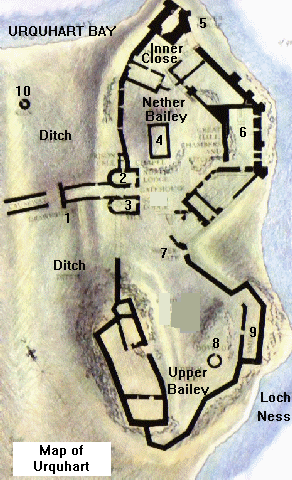
|
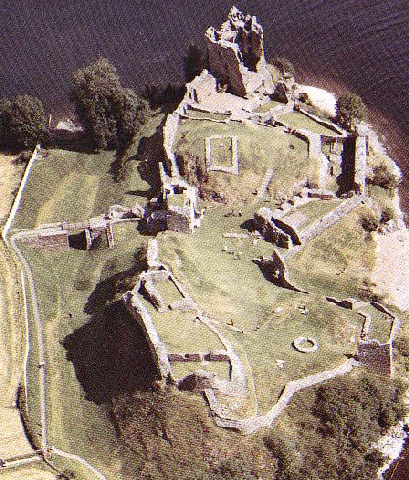
|
| Castle Layout | Ariel View |
1) Drawbridge- crossing a rock-cut ditch, 30 m across at widest, and 5 m deep
2) Gatehouse- North Lodge, with prison cell in little area directly above it
3) Gatehouse- South Lodge, converted into the kiln house
4) Chapel- place of worship for the lord, his lady, and the castle inhabitants
5) Tower-house- The tower itself dates back to the 16th century; it's basement walls- the 14th century
6) Great Hall, Chambers, & Kitchen- for entertaining & meetings. The kitchen was in the still intact basement
7) The Watergate- Secondary entrance to the castle; where all the supplies were brought in.
8) Dovecot- where the pigeons were kept- pigeon meant was the staple diet for many medeival castles
9) Smithy- iron goods and implements for the castle were made here
10) Kiln- secondary kiln- probably used before the South lodge was converted to the kiln house.


